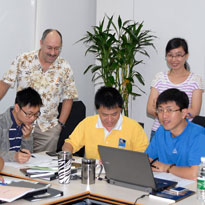Switching/Routing
- Course:Switching/Routing
- Course ID:SW-ROUTE Duration:5 days Where: Your Office (7+ Persons)
- Download Course Description (PDF)
Available as a private, customized course for your group at your offices or ours and in some cases as a WebLive(TM) class.
Course Outline
- Introduction to the Open Systems Interconnect (OSI) Model
- Physical Layer Protocols
- Data Link Layer Protocols
- Network Layer Protocols
- Transport Layer Protocols
- Session Layer Protocols
- Presentation Layer Protocols
- Application Layer Protocols
- Understanding Network Architectures
- Bus, Ring and Star Topologies
- Basic Device Functionality
- LAN Topologies
- WAN Topologies
- Binary Number Systems
- Binary Formats and Weighting
- Binary Coded Decimal
- Hexadecimal
- Converting between Binary Formats
- Physical Layer Functionality
- Channel Capacity
- Binary Coding (RZ, NRZ, Manchester, uni-polar and bipolar)
- Clock and Data Recovery
- LAN Physical Layer Protocols (IEEE 802.3)
- WAN Physical Layer Protocols (Frame Relay, SONET, CWDM, DWDM, Metro Ethernet, VPLS)
- Data Link Layer Functionality
- PHY Layer Coding
- Media Access Control (MAC)
- Ethernet Networking Evolution
- MAC addressing
- Ethernet II Frame Format
- Logical Link Control (LLC)
- Ethernet Switching Methodology
- Virtual Local Area Networks (VLANs)
- Spanning Tree Protocol (STP)
- Internet Protocol Addressing
- IPv4 Structure
- IPv6 Structure
- Class A, B, C and D Networks
- Private Network Addressing
- Subnetting and Variable Length Subnet Masking (VLSM)
- Internet Protocol (IP) Functionality
- IP Network Architectures
- IP Frame Format
- IP Protocols (ping, traceroute)
- Address Resolution Protocol (ARP)
- Layer 3 Routing
- Static and Default Routing
- Routing Tables
- Routing Algorithms
- Interior Gateway Protocols (RIP, EIGRP, OSPF, IS-IS)
- Exterior Gateway Protocols (BGP)
- Equal Cost Multipathing (ECMP)
- Route Redistribution
- Transport Layer Functionality
- Transmission Control Protocol (TCP)
- User Datagram Protocol (UDP)
- Reliable Transport
- Port Numbers for Common Services
- LAN and WAN Network Interoperability
- Frame and Packet Encapsulation
- Address Translation
- Point to Point Protocol (PPP)
- Authentication Methods
- Networking Example
- Physical through Transport Layer Functionality
- Review Network Architectures and Topologies
- OSI Layer Interactions
- Wrap-up
- Course Recap and Q/A
- Evaluations
Course in a Nutshell
Network protocols form the foundation and support successful and effective network architectures. Therefore it is imperative to understand the functionality of physical layer, switching, and routing protocols in order to leverage performance advantages. This course delivers a layered model and presents the interaction between common protocols, features and services, so that the student may develop a holistic view of successful and performance based network deployments.
Customize It!
Let us know your reason for studying switching and routing so we can customize the course to your specific needs. If you do not possess prior knowledge of basic network functionality, we can augment the course material to deliver a solid foundation for students with varying degrees of expertise.
Learn How To
- Describe common physical layer LAN and WAN services
- Understand Ethernet network architectures (Layer 2 switching)
- Implement an effective IP addressing scheme including subnetting
- Understand the functionality of routing protocols including OSPF, EIGRP, ISIS, BGP and RIP (Layer 3 Routing)
- Understand TCP and UDP transport layer protocols including reliable delivery
Aimed At
This course is aimed at network, server and storage administrators who are tasked with implementing basic, intermediate and complex network architectures that require an intimate working knowledge of a variety of common and standard protocols, features and services.
Prerequisites
Those wishing to take this course should have a basic knowledge of networking requirements and functionality. Detailed knowledge of specific protocols and their operation is not required.
- "Liked everything about this course. Instructor is well prepared and explains everything well. Handbook is excellent; everything was detailed inside the handbook. I wanted to know how to configure routers and switches and I did get it." – TT, Data Network Technician, Asia-Pacific Telecom Operator

